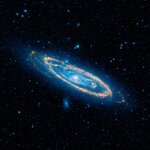Space

Comets are thought to be some of the oldest, most primitive bodies in the solar system, but new research on the comet Wild 2 indicates that inner solar system material was transported to the comet-forming region at least 1.7 million years after the formation of the oldest solar system solids.
Published in Science, the research provides the first constraint on the age of cometary material from a known comet. The findings are published in the Feb. 25 edition of Science Express.
The NASA Stardust mission to comet Wild 2, which launched in 1999, was designed around the premise that comets…
IT arrived. With little fanfare, an ordinary cardboard box full of packing peanuts has thrown my life into panic and confusion. For the mighty packing slip says it all. "Parts&Packing List". Inside is... a piece of paper. And, hopefully, buried under the packing peanuts, also a satellite.
My satellite. My InterOrbital pico-satellite. "Project Calliope", the satellite. The THING I'm BUILDING in my BASEMENT (dum-dum-dah-dum!). Did you ever wonder just what a satellite is made of? The answer is... this!
Pico-chu
That's it. That's a picosatellite. Nearly every piece, excluding instruments…

Did you ever wonder why some people become astronomers? I asked random astronomers at last month's AAS meeting, and in my latest 365DOA podcast, you can find out what each said-- and how each explained their research in 30 seconds or less. For the big picture, the stories of why ordinary, sane people become astronomers, it turns out we get bit by the astronomy bug early.
Either in elementary school, we've already decided, or in high school, we get inspired. By the time people hit college, the ones who want to be career astronomers have already decided that's their path.
We…
Astronomers have detected the astronomical equivalent of prehistoric life in our intergalactic backyard: a group of small, ancient galaxies that has waited 10 billion years to come together. These "late bloomers" are on their way to building a large elliptical galaxy.
Such encounters between dwarf galaxies are normally seen billions of light-years away and therefore occurred billions of years ago. But these galaxies, members of Hickson Compact Group 31, are relatively nearby, only 166 million light-years away.
Writing in the Astronomical Journal, researchers say the new images of this…
Primitive stars are thought to have formed from material forged shortly after the Big Bang, 13.7 billion years ago and are mainly observed in the Milky Way. But now researchers are reporting that they have uncovered more primitive stars located in neighboring dwarf galaxies. The discovery was made possible by much more detailed spectra obtained with the UVES instrument on ESO's Very Large Telescope.
"We have, in effect, found a flaw in the forensic methods used until now," says Else Starkenburg, lead researcher on the project. "Our improved approach allows us to uncover the primitive stars…
New images from NASA's Fermi Gamma-ray Space Telescope showing where supernova remnants emit radiation a billion times more energetic than visible light have brought astronomers a step closer to understanding the source of cosmic rays.
Cosmic rays consist mainly of protons that move through space at nearly the speed of light. In their journey across the galaxy, the particles are deflected by magnetic fields, which scrambles their paths and masks their origins.
"Understanding the sources of cosmic rays is one of Fermi's key goals," said Stefan Funk, an astrophysicist at the Kavli Institute for…
Scientists have known for more than a decade that galaxies in the early universe produced many more stars than galaxies today. But what has remained unknown is why. Now, researchers writing in a recent issue of Nature say they may have an explanation for this astronomical mystery.
"[T]hree to five billion years after the Big Bang...galaxies churned out new stars at a much faster rate than they do now," said Michael Cooper, a postdoctoral Spitzer fellow at the University of Arizona's Steward Observatory.
"What we haven't known is whether this was because they somehow formed stars more…

The highest jump ever made was by Joseph Kittinger in 1960--31 km. This year, astronaut Felix Baumgartner will attempt a 36 km jump, and there is talk about Michael Fournier attempting a 40 km jump. According to medical director Jonathan Clark (via Science magazine, subscription required), jumps from this height have a variety of health risks, including nitrogen bubbling from the blood, sweat freezing on the skin, and spinning while falling -- leading to a brain hemorage. There's also the issue of what will happen when he breaks the sound barrier, which could produce massive shock-waves (…
It takes Saturn almost thirty years to orbit the Sun, with the opportunity to image both of its poles occurring only twice in that period. 2009 brought a unique chance for Hubble to image Saturn with the rings edge-on and both poles in view. At the same time Saturn was approaching its equinox so both poles were equally illuminated by the Sun's rays.
These recent observations go well beyond just a still image and have allowed researchers to monitor the behaviour of both Saturn's poles in the same shot over a sustained period of time. The movie they created from the data, collected over several…

Every galaxy we know about has a collection of black holes that can each be up to 10 times the sun’s mass. In addition to these black holes, there is one to rule them all; a supermassive black hole embedded in the heart of each galaxy, roughly one million to one billion times the mass of the sun.
About 10 percent of these supermassive black holes feature jets of plasma, or highly ionized gas, that extend perpendicularly from each side of the event horizon — the region from which nothing, not even light, can escape. By spewing huge amounts of mostly kinetic energy from the black holes into the…